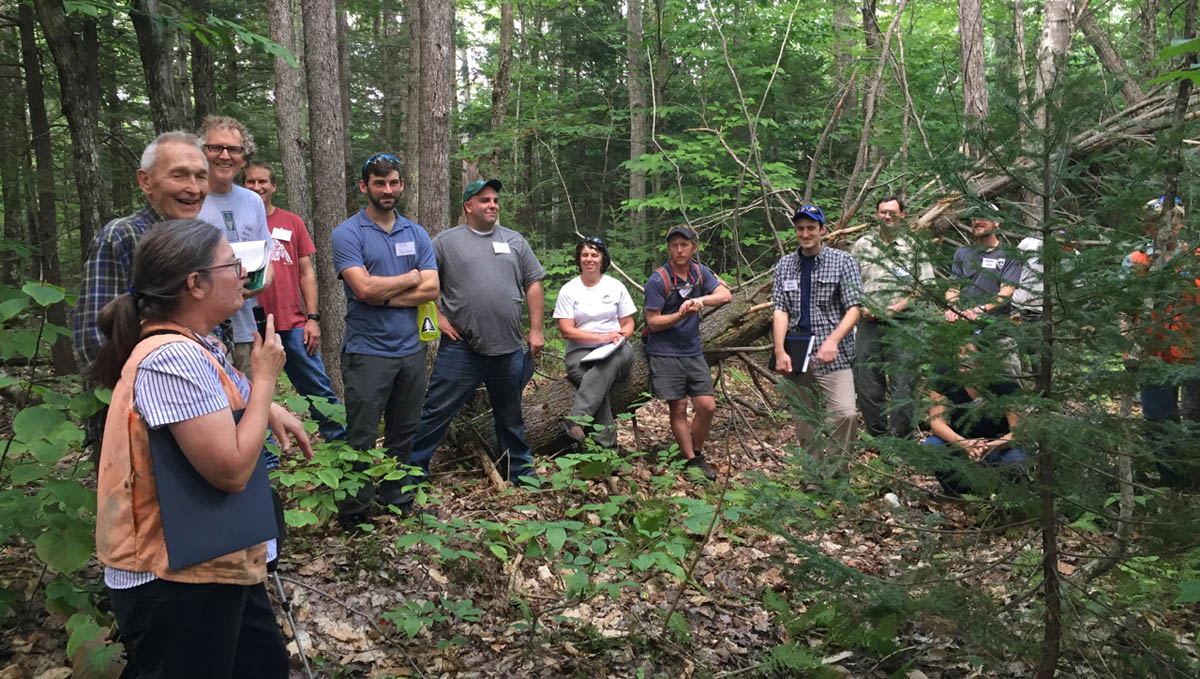
In early September, VFF staff ventured into our neighboring White Mountains of New Hampshire to take part in a two-day workshop in Northern Hardwood Silviculture held at the 5,500-acre US Forest Service Bartlett Experimental Forest.
Bartlett is part of one of our country’s great legacies—a network of national forests that encompasses about 190 million acres across the country. It’s a legacy that dates to the Forest Reserve Act of 1891, which allowed federal lands to be set aside as forest reserves. In the eastern US, where most forestland was privately held by that time, intensive clearing and poor roading of forests had led to widespread erosion and flooding. To protect navigable waterways, the Weeks Act of 1911 further authorized the purchase of private lands for national forests. That legislation is the reason we’re so fortunate to have some 20 million acres of National Forest land in the eastern United States.
Across these newly created national forests, the US Forest Service established more than 80 experimental forests, each a field laboratory for the study of forest ecology and management. Bartlett has been a center for research on the northern forest ecosystem for more than 85 years, with timber production and wildlife habitat enhancement as the primary focus.
In recent years, the research at Bartlett has explored ways to successfully regenerate northern hardwood forests. After many years of practicing diameter limit cutting and/or individual tree selection, regeneration had become dominated—if not locked up—by a thicket of American beech, hobblebush, and striped maple, particularly on dry and acidic sites, which abound in the Granite State of New Hampshire.

During the workshop field tour, we learned how researchers successfully knock back beech, hobblebush, and striped maple by completely clearing the forest in ¾-acre or larger patches under summer conditions, and obliterating remnant root systems by churning up the soil. This intensive tactic favors aspen, white birch, and other shade-intolerant tree species in the short term, followed by shade-tolerant species like sugar maple and yellow birch in the much longer term. In most cases these treatments have not required herbicides. Some have not required pre-commercial thinning. The larger patches are also ideally suited for grapple skidders and whole tree harvesting. The combination of these factors has often made the small clearcuts financially viable and attractive to loggers and foresters.
Although the “forest nuking” demonstrated at Bartlett is effective in getting beyond the beech, striped maple, and hobblebush, it’s a different model of forestry than what we’re up to at Vermont Family Forests. It more closely resembles industrial agriculture than the tending of a self-renewing forest ecosystem. Key elements such a large dead wood, standing snags, significant quantities of soil carbon, and other lifeboats are depleted from the treated sites.
At VFF, we consider well-designed access paths and trails to be a key part of forest health. They’re one of the first things we attend to when working with a landowner. When forests experience soil compaction and erosion, it’s often from poor access trail design and maintenance. When deciding where access trails should be placed, we first identify where we don’t want them to be. We stay out of sites with slopes of 35% or more, as well as wetlands, beaver meadows, vernal pools, seeps, and their buffers. We always avoid remnant patches of old growth forest. We make sure that the access trail network, including log landings, occupies no more than 5% of the treated land base and that the trails have an average grade of 7% or less. Trails are laid in with enough broad-based dips and other drainage to ensure that we slow, spread, and sink the flow of storm runoff.
The ecological imperative of this careful approach to access trail building was validated during one of the presentations during the Bartlett workshop, in which researchers noted a clear correlation between road corridors and a decline in health of adjacent trees. In contrast to VFF’s approach, the placement and building of access trails at Bartlett is left to the logging company awarded the contract to carry out a particular timber sale.
As for vegetation management, here in the Center-West Ecoregion, we are often blessed by sweet, calcium-rich, mesic sites where sugar maple, yellow birch, black cherry, red oak, white ash, and basswood like to grow. We encourage landowners to try to avoid the problem of too much beech, hobblebush and striped maple by promoting tree species richness. To burn a lot of beech polewood in their wood stoves. To allow high quality trees to grow to ripe old ages. To leave lots of wind-blown trees unsalvaged and add to the downed-wood mix with girdling and drop-and-leave techniques, since one of the many benefits of downed woody debris is that it can protect tree seedlings from deer browsing.
We learned a lot from our Bartlett visit. We have sites and conditions where we may follow at least some of their leads. What we saw at Bartlett helps us to anticipate problems and to take steps to avoid them. And we are re-committed to learning how self-willed forests prosper and how to best safeguard their resilience in our interactions with the forest community.





